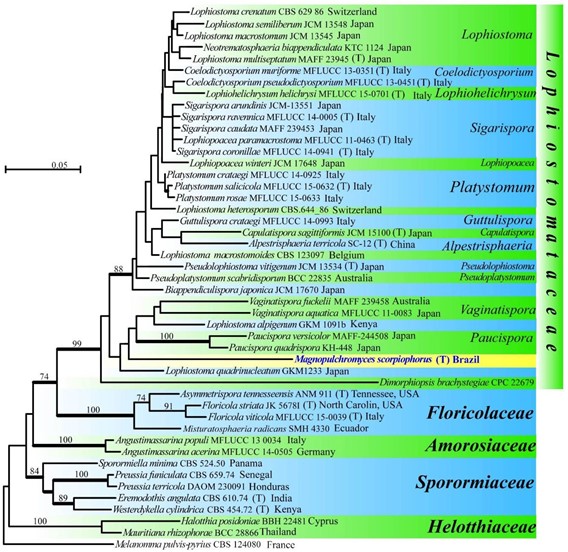Magnopulchromyces scorpiophorus L.B. Conc., Gusmão & R.F. Castañeda, sp. nov. Fig. 14
MycoBank number: MB 556428; Index Fungorum: IF 556428; Facesoffungi number: FoF 06110;
Etymology: From the Latin: scorpiophorus-, referring to the scorpioid unilateral, branched conidiophores.
Holotype: HUEFS 234842.
Saprobic on decaying leaves. Asexual morph: Colonies on the natural substrate effuse, granulose, brown. Mycelium mostly superficial, composed of branched, septate, brown hyphae, 3–4 µm diam. Conidiophores macronematous, mononematous, erect or prostrate, scorpioid-unilateral branched, brown below, pale dirty brown or pale greyish brown toward the apex, multiseptate, up to 300 µm long, 5–8 µm wide. Conidiogenous cells monoblastic, cuneiform, sub-doliiform, intercalary and terminal, pale greyish brown to pale brown, smooth, 5–7 × 5–8 µm. Conidial secession schizolytic. Conidia acropleurogenous, complex, lenticular staurospore, somewhat stellate or irregular staurospore, variegated, smooth, 25–35 × 24–31 µm, multicellular, com- posed of: (i) a more or less central primary cell, dark brown, 6.5–11 × 9–13 µm; (ii) 1–4 secondary cells brown, or dark brown, 4.5–7 × 5–10 µm, lateral, radial or cruciate arranged beside or surrounding the primary cells; (iii) 3–8 tertiary cells pale brown, 4.5–6 × 6–8 µm, beside the secondary cells; (iv) 6–13 satellite cell conical, trapezoid, mammiform or hemispherical, straight or slightly curved, greyish brown or very pale brown. Sexual morph: Undetermined.
Culture characteristics: Cultures growing on CMA reach- ing 30 mm diam after 30 days at 25 °C; moderate aerial mycelium, circular, umbonate, regular edges, dark brown.
Material examined: BRAZIL, Bahia State, Pindobaçu, Serra da Fumaça, 10°39′ S, 40°22′ W, on decaying leaves of unidentified plant, 26 July 2016, L.B. Conceição, (HUEFS 234842, holotype); ex-type living culture CCLAMIC 206/16.
GenBank numbers: ITS: MG594647; LSU: MG594648; TEF1: MG597248.
Notes: – Maximum likelihood tree based on a combined LSU, ITS and TEF1-α sequence dataset shows the phylogenetic position of Magnopulchromyces scorpiophorus (Fig. 15).

Fig. 14 Magnopulchromyces scorpiophorus (HUEFS234842, holotype). a–b Detail of conidiogenous cells and conidi- ophores. c Conidia. d Scorpioid growth development on natural substrate. Scale bars: 20 µm

Fig. 15 Maximum likelihood tree based on a combined LSU, ITS and TEF1-α sequence dataset. Numbers above branches indicate maximum likelihood bootstrap values ≥ 70%. Thickened branches indicate Bayesian posterior probabilities ≥ 0.95. The tree is rooted with Melanomma pulvis-pyrius (CBS 124080). Magnopulchromyces scorpiophorus is highlighted in yellow. Culture collection numbers are given after taxon names
